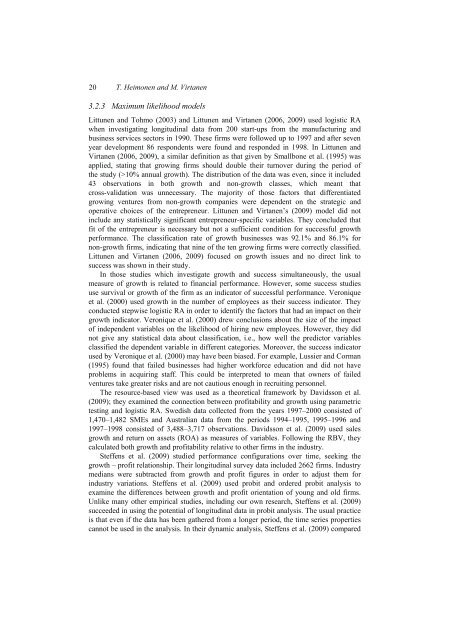dissertation in pdf-format - Aalto-yliopisto
dissertation in pdf-format - Aalto-yliopisto
dissertation in pdf-format - Aalto-yliopisto
Create successful ePaper yourself
Turn your PDF publications into a flip-book with our unique Google optimized e-Paper software.
20 T. Heimonen and M. Virtanen<br />
3.2.3 Maximum likelihood models<br />
Littunen and Tohmo (2003) and Littunen and Virtanen (2006, 2009) used logistic RA<br />
when <strong>in</strong>vestigat<strong>in</strong>g longitud<strong>in</strong>al data from 200 start-ups from the manufactur<strong>in</strong>g and<br />
bus<strong>in</strong>ess services sectors <strong>in</strong> 1990. These firms were followed up to 1997 and after seven<br />
year development 86 respondents were found and responded <strong>in</strong> 1998. In Littunen and<br />
Virtanen (2006, 2009), a similar def<strong>in</strong>ition as that given by Smallbone et al. (1995) was<br />
applied, stat<strong>in</strong>g that grow<strong>in</strong>g firms should double their turnover dur<strong>in</strong>g the period of<br />
the study (>10% annual growth). The distribution of the data was even, s<strong>in</strong>ce it <strong>in</strong>cluded<br />
43 observations <strong>in</strong> both growth and non-growth classes, which meant that<br />
cross-validation was unnecessary. The majority of those factors that differentiated<br />
grow<strong>in</strong>g ventures from non-growth companies were dependent on the strategic and<br />
operative choices of the entrepreneur. Littunen and Virtanen’s (2009) model did not<br />
<strong>in</strong>clude any statistically significant entrepreneur-specific variables. They concluded that<br />
fit of the entrepreneur is necessary but not a sufficient condition for successful growth<br />
performance. The classification rate of growth bus<strong>in</strong>esses was 92.1% and 86.1% for<br />
non-growth firms, <strong>in</strong>dicat<strong>in</strong>g that n<strong>in</strong>e of the ten grow<strong>in</strong>g firms were correctly classified.<br />
Littunen and Virtanen (2006, 2009) focused on growth issues and no direct l<strong>in</strong>k to<br />
success was shown <strong>in</strong> their study.<br />
In those studies which <strong>in</strong>vestigate growth and success simultaneously, the usual<br />
measure of growth is related to f<strong>in</strong>ancial performance. However, some success studies<br />
use survival or growth of the firm as an <strong>in</strong>dicator of successful performance. Veronique<br />
et al. (2000) used growth <strong>in</strong> the number of employees as their success <strong>in</strong>dicator. They<br />
conducted stepwise logistic RA <strong>in</strong> order to identify the factors that had an impact on their<br />
growth <strong>in</strong>dicator. Veronique et al. (2000) drew conclusions about the size of the impact<br />
of <strong>in</strong>dependent variables on the likelihood of hir<strong>in</strong>g new employees. However, they did<br />
not give any statistical data about classification, i.e., how well the predictor variables<br />
classified the dependent variable <strong>in</strong> different categories. Moreover, the success <strong>in</strong>dicator<br />
used by Veronique et al. (2000) may have been biased. For example, Lussier and Corman<br />
(1995) found that failed bus<strong>in</strong>esses had higher workforce education and did not have<br />
problems <strong>in</strong> acquir<strong>in</strong>g staff. This could be <strong>in</strong>terpreted to mean that owners of failed<br />
ventures take greater risks and are not cautious enough <strong>in</strong> recruit<strong>in</strong>g personnel.<br />
The resource-based view was used as a theoretical framework by Davidsson et al.<br />
(2009); they exam<strong>in</strong>ed the connection between profitability and growth us<strong>in</strong>g parametric<br />
test<strong>in</strong>g and logistic RA. Swedish data collected from the years 1997–2000 consisted of<br />
1,470–1,482 SMEs and Australian data from the periods 1994–1995, 1995–1996 and<br />
1997–1998 consisted of 3,488–3,717 observations. Davidsson et al. (2009) used sales<br />
growth and return on assets (ROA) as measures of variables. Follow<strong>in</strong>g the RBV, they<br />
calculated both growth and profitability relative to other firms <strong>in</strong> the <strong>in</strong>dustry.<br />
Steffens et al. (2009) studied performance configurations over time, seek<strong>in</strong>g the<br />
growth – profit relationship. Their longitud<strong>in</strong>al survey data <strong>in</strong>cluded 2662 firms. Industry<br />
medians were subtracted from growth and profit figures <strong>in</strong> order to adjust them for<br />
<strong>in</strong>dustry variations. Steffens et al. (2009) used probit and ordered probit analysis to<br />
exam<strong>in</strong>e the differences between growth and profit orientation of young and old firms.<br />
Unlike many other empirical studies, <strong>in</strong>clud<strong>in</strong>g our own research, Steffens et al. (2009)<br />
succeeded <strong>in</strong> us<strong>in</strong>g the potential of longitud<strong>in</strong>al data <strong>in</strong> probit analysis. The usual practice<br />
is that even if the data has been gathered from a longer period, the time series properties<br />
cannot be used <strong>in</strong> the analysis. In their dynamic analysis, Steffens et al. (2009) compared
















